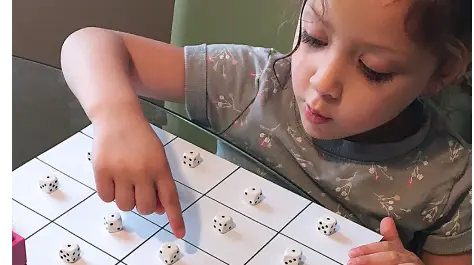1, 2, 3, 4, 5 …
One of first learning experiences that you can provide for your young child is counting. However, counting is really a complex experience and an important building block for understanding the concepts of numbers and mathematics.
Usually, the first counting-related skill that children learn is the ability to recite the words for the numbers in the correct order: one, two, three, four, five. . . . This memory skill is important (just as it is useful to know The Alphabet Song in order to learn the names and order of the letters of the alphabet), yet even as children begin to recite the numbers in order, they typically don’t have any understanding of what the words one, two, three, and so forth actually mean. According to the National Council of Teachers of Mathematics, the standard for numbers and operations for prekindergarten through grade 2 is “count with understanding and recognize ‘how many’ in sets of objects. . . . ”
When children “count with understanding,” they understand that the word one refers to one object of any kind, the word two refers to two objects, and so on.
Everyday experiences can lead children to discover and understand the relationship between quantities and the words that are used to talk about numbers. For example, when counting, children need to learn that there is a one-to-one correspondence of object and number (like matching one person to one cookie) and also that counting two after one means that the first and second objects need to be added together to make the two, and so on!
When you give your child things to count, start with the objects displayed in a line, so that he or she can see each object individually and count the objects sequentially:
X X X X X X X X X X (10)
Counting from left to right and touching each object as it is counted helps your child to understand the one-to-one correspondence of an object to a number. In addition, moving the objects closer together while he or she counts will help your child to understand that the number four, for instance, refers to all of the objects counted up to four and not just the one called four:
XXXX (4) X X X X X X
You can also provide practice in recognizing sets of objects by the way they are grouped, like the dots on a six-sided die. Children can count the dots, recognize the pattern, and learn that they won’t have to count again as the set/pattern becomes associated with the quantity it represents. This simple game can help:
- Hold five or six small objects (buttons, grapes, pennies) in your hand.
- Roll out a different number of them.
- Tell your child to look at the objects you rolled and quickly name the quantity without counting.
- Repeat this activity.
After a while, your child will very quickly be able to identify and tell you the number for each quantity of objects.
Additionally, provide practice in recognizing sets of objects by the way they are grouped in a line, like this:
X
X X
X X X
X X X X
X X X X X
The most important thing about teaching counting and other early mathematics concepts to your child is that he or she should see numbers as part of his or her real-life experiences. Look for opportunities to count with your child whenever possible. For example, you might count everyday items, such as these:
- packages of macaroni or beans in the kitchen
- leaves that have fallen off of a tree
- buttons on a jacket or sweater
- school buses you see on the drive to school
- forks, spoons, knives, plates, and napkins to match the total number of people eating together

To nurture your child’s grasp of numbers and counting, continue to ask him or her questions like these:
- How many shells did you find? Please count them one by one to find out.
- Did you look at all of the petals on this flower? Please count them to find out how many petals there are in all.
- See these two beans? Let’s add two more beans. Please put them together and count them to find out how many beans you have in all.
Integrating counting into your child’s life will help him or her to understand that counting is an essential skill that’s important to learn—like learning to read.
And speaking of reading, here are a few captivating children’s books that will help your child develop the concept of counting:
- Doggies by Sandra Boynton
- 1-2-3: A Child’s First Counting Book by Alison Jay
- Roar! A Noisy Counting Book by Pamela Duncan Edwards
- Miss Spider’s Tea Party: The Counting Book by David Kirk
- Ten Little Ladybugs by Melanie Gerth
The time you spend with your child on this subject will reap helpful rewards when he or she encounters numbers—in preschool, pre-k, or kindergarten—and already understands that these symbols and words actually represent quantities. Mathematics educators call this understanding number sense, and it’s an essential foundation for your child’s future mathematics learning.
The key foundation skill of counting and the concept of quantity will help your child develop an awareness about numbers that will serve him or her forever. This is vital, because your youngster can count on counting being around for his or her whole life!

